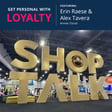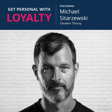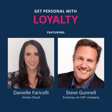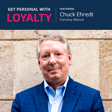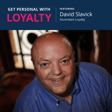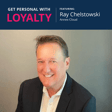Become a Creator today!Start creating today - Share your story with the world!
Start for free
00:00:00
00:00:01

Reset the Way You Approach Gamification (ft. Barry Kirk)
This episode dives deep into the loyalty game with Barry Kirk, Principal Consultant/CX Practice Leader at Chapman & Co. Prepare to walk away with a whole new mindset on how to approach gamification, know where to look for inspiration, understand how B2B brands can leverage it, hear where most companies miss the mark and find out some simple ways to get started—the right way.
Transcript
Introduction and Guest Welcome
00:00:10
Speaker
Get Personal with Loyalty, where we're discussing using loyalty to deliver personalized, relevant customer experiences. Hello, everybody. Welcome to another episode of Get Personal with Loyalty. I'm your host, Erin Reese, and today I'm here with Barry Kirk.
00:00:25
Speaker
who is the principal and CX practice leader at Chapman & Co. Welcome, Barry. Thank you, Erin. Excited to be here with you today, talking about one of my favorite topics.
Barry Kirk's Background in Gamification and Loyalty Marketing
00:00:35
Speaker
I love it. Yes, we're going to talk about gamification. And for people in the audience, Barry and I have known each other for probably getting close to 20 years now. And Barry is one of those people that when gamification concept first came out, he really dug in and got to know it. Hence, we're having the conversation with him today.
00:00:54
Speaker
So not to steal all of your thunder around your background, Barry, do you want to introduce yourself and talk about where you've been in this space and where you are today? Sure. Just really briefly and probably for your audience in particular.
00:01:07
Speaker
So I've spent most of my career in the loyalty and the loyalty marketing space. I've been doing that probably about 25, 30 years at this point. And predominantly in consulting and strategy for companies that are designing or redesigning their loyalty programs. But during probably about the middle of my career, I got involved in gamification as a specific area of practice or expertise.
00:01:29
Speaker
I actually left Loyalty for a while and went and worked with a startup in Silicon Valley that was specifically focused on delivering gamification as a technology. So got to spend about two years doing nothing but helping people gamify things. And that really changed my entire view of what is get in. Sometimes not so great about gamification and what are the best ways to do that. And today my focus has actually shifted a bit again. Loyalty is still a big part of what I do, but at Chapman & Co. also do a lot of work with companies in pure customer experience.
00:01:58
Speaker
And also particularly, which I'll talk about maybe in a little bit with customer service, which is something that I've been focusing lately on gamifying.
Gamification in Loyalty Programs
00:02:05
Speaker
So we can kind of talk about how that, what that looks like. Ooh, I'm intrigued. That's great. Well, and I like the positioning of that too, because while I certainly sit in a world of programmatic loyalty, when I think you and I are both the same way, it's much broader than that. It's really about the relationship with the customer and all the different touch points and making sure that we're delivering the right experience at the right time.
00:02:27
Speaker
All right. Well, gamification, excited to dig in. I do remember when you went down that path and I thought, well, why do we need this thing called gamification? Because loyalty, it's a game concept. We were already gamifying. So why, why do we need this other level? We'd love to know kind of what intrigued you then and what was different about a traditional, it's called a points program and what gamification could be. Yeah. I mean, it's a great point, Aaron. And I think people miss it a lot. Even people who
Understanding Game Mechanics vs. Game Dynamics
00:02:55
Speaker
do loyalty, you know, in their career.
00:02:57
Speaker
miss that loyalty programs are game of fight experience. They're some of the most effective.
00:03:02
Speaker
gamified experiences. So when you think about it, so maybe back up for a second, usually when folks ask me, well, how do you define gamification? What I will generally say it is, it is using the psychology and techniques of game-like experiences to enhance something that is not a game. So if you think about that, that's what a loyalty program is. A loyalty program is a construct put on top of buying things to make that experience of buying things more interesting or more engaging. And so when we take loyalty mechanics like
00:03:32
Speaker
points and tiers and rewards.
00:03:35
Speaker
and campaigns and layer that on top of the act of engaging with a business, that is literally gamifying that experience. The reason I went down the path more directly though, was I looked at that and said, well, we did a good job of like taking two or three mechanics and sticking them in game mechanics into a loyalty program. And then we stopped. And so arguably today, loyalty still represents loyalty programs in particular, probably the most prevalent gamified experiences that we encounter as consumers.
00:04:03
Speaker
And yet they're the least sophisticated because we basically adopted three, two, three of the mechanics of games. And then like, we're good. And we haven't really advanced them that much in the last 20 years. And I bring this up not as a criticism, but as an opportunity. I think there's so much more that you could be doing with your loyalty program if you pushed into the era of gamification to make it more competitive with programs that just aren't doing that.
00:04:27
Speaker
Okay, I'm intrigued. So can we delve into that? Like what are the things that we should be or could be doing that, that elevate?
Enhancing Loyalty Programs with Game Dynamics
00:04:35
Speaker
Yeah. So one of the things I think where loyalty programs have gotten stuck is overly focusing on what I have referred to already as game mechanics. It might be good for me to parse really quickly the difference between game mechanics and the other half of gamification, which I refer to as game dynamics. So game mechanics are the things we always think about when we think about gamification.
00:04:56
Speaker
That's points, tiers, rewards, progress bars, badges, which get way too much focus for their value. But oftentimes that's the next thing everybody goes to, particularly loyalty programs. Like I'll give you a badge for doing that thing. We only, we can talk a bit about why badges are generally not a great technique and overused, but in that focus on game.
00:05:20
Speaker
which are the visible, interactable components of games that we've taken and put into that experience. We have missed a richer focus that could be placed on game dynamics, which is the psychology of gameplay. So what is a game dynamic? That could be competition. So a lot of times we think about games, they're competitive. That's a game dynamic, a psychological component that makes that experience more engaging, right? If I can play against somebody, the experience is more interesting.
00:05:50
Speaker
It could also be collaboration. It could be, well, I want to create an experience where I want people to cooperatively lean in. It could be social proof. I'm more inclined to engage in that experience if I can see what other people are doing in that experience. So think about that. Social proof, super powerful. But how many loyalty programs do you engage in? Will you have a clue what anybody else is doing? There could be 8 million people in that program. And as far as you know, it's one person. It's you, because you don't know what anybody else is doing. There's lots of other game dynamics, play, discovery,
00:06:21
Speaker
Surprise. So all of those types of things, discovery, are elements of gamification that I think would serve loyalty programs to put more focus on, literally sit down one day and say, where's the play in our experience? Where do we have something that makes us fun? What are the surprising elements? What do we give people an opportunity to explore on their own to learn more about, rather than just everything being like, go read the T's and C's.
00:06:47
Speaker
That's the big opportunity that I think most loyalty programs miss that, frankly, other consumer experiences are doing better than loyalty programs at today. Lots to unpack there, but I like what you just said there at the end. Loyalty programs are missing, but other experiences are doing. What are some of those?
Successful Gamification Examples
00:07:05
Speaker
I would say if you want to look for really good examples today of consumer-based experiences that are doing gamification really well, the obvious place to look to is healthcare and particularly just health-related
00:07:17
Speaker
apps and experiences. So I think about, you know, like weight loss apps like noon are completely gamified, right? Everything in there is about keeping you on track exercise. I have a Peloton. I love my Peloton. I'm part of that, you know, cult of Peloton and Peloton is pretty gamified. You know, it keeps track of all sorts of statistics about your experience that lets you track how far you are. It lets you also see what your friends are doing. So it's got social proof, like embedded all over their experience. So.
00:07:47
Speaker
I can also join with people in challenges, that sort of thing. So doing a much better job there. Fitbit would be another one that does that really well. So it creates that experience. The other one that sits outside of healthcare, but I think is also about self-improvement is our apps like Duolingo, where I'm trying to learn a new language and they do a great job of incorporating all kinds of little fun game mechanics. But if you think about it for a minute, what are those, all those experiences have in common
00:08:15
Speaker
there is a challenging experience that I wanna engage in where the payoff is pretty far off in the distance. If I wanna get healthier, if I wanna lose weight, if I wanna learn Italian, right? I'm not gonna get there tomorrow. And what that tells you is those experiences have designed gamification in there because they know I need a way to keep you nudging forward little by little and giving you something that will keep your brain active, keep you engaged and give you a sense of progress. That is also true, Aaron, of a lot of loyalty programs.
00:08:44
Speaker
If I earn 10 points today, there's not anything I can do with that in most programs. I need to get to 500 points before I can do something. So same thing, my payoff is in the distance. And so thinking about how you can use gamification a way, say a weight loss program does or a learn language program to continue to move me forward little by little so I don't disengage. Because I would say if there's one risk that every loyalty program has
00:09:09
Speaker
It's disengagement. I'm sure we're all aware that when you ask a company, well, how's your loyalty program doing? The stat they always give you is how many people are enrolled in their program. What they never give you is how many people are actually engaged in the program. Because most people sign up and then disengage. And that's the, I think, is really the benefit of looking at gamification more closely.
00:09:30
Speaker
It's just really good for keeping people committed to something that is a long path toward the payoff. Super interesting.
Gamification Strategies in Retail and B2B
00:09:35
Speaker
Thank you for all that. As you're talking, I'm thinking about, I guess the brands that are doing it, it just seems like, okay, well, their brand just fits that kind of model, but that might not actually be the case. They've just done a good job, so it makes it seem like something that's just logically complementary to what they're doing. If you're thinking about retail, just a regular apparel retailer,
00:09:57
Speaker
How would you go about thinking about competition or social proof? Maybe social proof would be something around getting into more of their everyday life around how were they wearing the clothes or different things that they're doing, where the brand supporting what their activity is. How do you go about that? Yeah, it's a good question. And I do say that if there's one market, that's kind of one, one vertical that I think is trying to do more with gamification and most of the others that we, when we think out more of consumer buying experiences,
00:10:27
Speaker
There is definitely more of it in retail. So some of that might be simply, what are the behaviors that you want me to engage in more by exposing me to statistics. Gamification is almost always about statistics of what's happening, of how many other people have bought an item.
00:10:44
Speaker
And you do sometimes see that in retail sites where like, you know, 500 people signed up for the program today or 25 people have this in their shopping cart, those kinds of things. Those are little nudges of Game of Five nudges that are saying, oh, I'm taking some of the statistics out of this experience and I'm letting you know what that looks like. The other thing that it could look like, and I think Starbucks is pretty good at this, is you create challenges that ask me to engage with the brand in a way that I don't normally do. So literally.
00:11:14
Speaker
You might know that you have certain products that customers are less likely to engage with. Or you might, in the example of like a quick-serve restaurant, you might have day parts where you don't have a lot of activity. And so what you do is begin to create challenges to say, I'm going to give you credit for showing up at a different time of day. If you come in and buy between this time and this time. Or I'm going to give you extra credit, some sort of reward.
00:11:38
Speaker
just for engaging with this category of product that you don't normally buy from. So the idea there is, I'm going to present it to you not as, do you want to buy this other thing? I'm going to present it to you as a challenge. Do this three times and you'll get this additional bonus. That is basically what you would do in a game, like go complete three tasks.
00:11:57
Speaker
going into adventure where you've got to kill three monsters, and then you get leveled up to the next part of the game. And the psychology of that is, what I'm trying to do is build that up as a habit. I have to really figure out what are the number of times I need to get a customer to engage in that particular behavior, say that cross purchase, to believe that I probably have set that now as a new standard for them. And for some businesses, you might have to say 10 times. For another, it might just be, hey, we know once they try that thing once, 50% of people get hooked.
00:12:26
Speaker
That's what you're trying to do there. Really appreciate what you just said around creating the challenges around using the QSR example. In my mind, it went to, could be an interesting way to kind of crawl, walk, run into gamification. That you don't have to just all of a sudden create something that is this wonderfully gamified experience like the health apps that you talked about or like Peloton that has all of these bells and whistles you can start with and frankly,
00:12:54
Speaker
edX cloud has this concept in just core to our platform is we call it an action series. And so you can do, just like you talked about, do these three things and then you can get rewarded and they don't always have to be a transactional. It can be some kind of engagement. So it could be something like, you know, hashtag the brand on this, sign up for a newsletter and make a transaction over this period of time. And then we can give you something.
00:13:21
Speaker
I like that, but I hadn't thought about it the way you took it to that next level there, though, where doing it more often and making sure people are creating the habit with people. So I fear that sometimes people that are using our technology might just be doing once or twice. It's like, oh, let's just hit this immediate need that I have. I need to send people to the
00:13:43
Speaker
restaurant at two o'clock on Tuesdays and they do that, it happens, but they're not maybe repeating it all the time. So I think that was a really great, great point. So thank
Games vs. Gamification
00:13:53
Speaker
you for that. I think that's really helpful as we're thinking about this. One of the things we haven't talked about yet, but I think it's maybe somewhat controversial and I think we feel the same way on this, but we are hearing a lot of requests for gamification, which is part of why I wanted to have this conversation. And I think it's,
00:14:11
Speaker
People are certainly using the word in different ways. And we're seeing things like spit and win and whack-a-mole and those types of things. I will share my bias. I look at that as that's engagement. To me, that's not gamification. To me, I see gamification more the way you're talking about it, more the psychology of it. So we'll have your take on maybe there's a time and a place for both or something.
00:14:35
Speaker
Yeah, no, it's a really good question. It is a common thing. I would say technically what people are confusing there is games versus gamification. They are separate concepts. They both have utility. It's not that one's better or worse. It's, but how do you use it? I think the easiest way to sort of parse out for yourself, what's the difference is one of those things, the game actually draws me out of the core experience I want people to engage in. So if you said the core experience is I want you to buy my product.
00:15:01
Speaker
mostly a game is something that says, well, I know that's not terribly interesting buying my product, but I'll create this little game on the side and you can go play that for a while and isn't that fun? That can have some utility just to keep people sort of their attention, their eyeballs on your website or whatever, but it is not the behavior you're actually wanting them to do. It's a distraction from the behavior which is purchasing or learning more about the brand, it's there. Gamification says, I already have a game.
00:15:28
Speaker
The game that I have is people engaging with my hotel, my airline, my retail location. And I already have behaviors I want them to do, which is exploring, understanding new products, buying, opening my emails, right? Gamification layers on top of that to make that experience itself more interesting and more engaging. So the question I would ask is, what is your real goal? Do you want to draw people out of your core experience and distract them with something fun and engaging?
00:15:58
Speaker
then add whack-a-mole to your experience. If what you wanna do, and maybe I'm a little biased here on where I would like people to think more, is no, I wanna draw people deeper into my core experience, which is interacting with my product set and making purchases or maybe telling other people about it, then gamification is the answer. And like I said, both can have utility, but the real core of doing well with gamification is saying, I already have a game. I don't need to add a game to it. My game is buying my product.
00:16:27
Speaker
And is that a fun, engaging, collaborative, competitive, discoverable experience? Most brands would probably have to say no, but that's where all your opportunity is to layer game mechanics and dynamics into make it
Educating Consumers with Gamification
00:16:40
Speaker
better. You're intriguing me. I know I would love this conversation. Again, going back to maybe the apparel example where they go, okay, well, how does it, does it really play? And the things you're talking about, having them learn more about the brand or more about the products and that type of thing, when we do.
00:16:56
Speaker
a lot of B2B programs. And one of the things I've been known to say is one of the differences between B2C and B2B is they both are looking to create engaging experiences. B2B tends to be more focused on training because it might be
00:17:14
Speaker
dentists wanting a dental company wanting to educate dentists on their various products. But as you're talking, I'm thinking, well, especially in today's world where everybody wants to know that we are supporting the earth and into organic health and wellness type topics and stuff, being able to actually engage your customer and sharing where your product came from.
00:17:39
Speaker
maybe the history of the company that actually might create a lot more engagement, a lot more connectivity with that customer at a whole nother level, but it doesn't seem like folks are necessarily doing that yet. So this could be a really interesting way to do
Behavioral Strategies for Gamification
00:17:53
Speaker
that. Yeah, I think there's just so much opportunity for bringing it in and understanding really at the core though starts with what are the behaviors or actions. So I love that you guys are using like that terminology that I want people to engage in, right? Yes. And I will say to your earlier comment,
00:18:08
Speaker
Education or learning is sort of the easiest place to apply this. In fact, if you've got kids, you already know that teachers gamify all kinds of things. They gamify how many books have you read this year and things like that. They're experts at gamification. We just don't tend to think of it that way. I mentioned a few minutes ago that one of the big projects that my team did this year was gamifying customer service training for a very large grocery brand here in the US. They wanted to train on customer service in a particular way.
00:18:35
Speaker
But we had to really think of what would engage the frontline teams and the frontline leaders. And we knew that putting them into training rooms with PowerPoint was not going to do it. And so we designed literally a board game set in their store that allowed them to sort of competitively move through a day in the store, encountering challenging sort of customer interactions and working through them together. And there was a scoring and a way to win.
00:18:59
Speaker
but the game was teaching them all the techniques of customer service. So we just didn't have them play a game because that would be interesting. We gamified the learning content and that's been very effective and they're getting ready to do the second version of this experience now too, which we're making different because we don't want them to play the same game twice. But the game was about the learning experience.
00:19:19
Speaker
Let me contrast that though with what you said about say in a B2B environment. Some of that might be about learning more about your products, but I can think of a whole host of behaviors that you probably want your B2B client to do that go beyond just learning about your product or buying it. It could be things like I need you to complete your profile. I need more information on you.
00:19:37
Speaker
I might want you to advocate. I might want you to try out one of my other products that you haven't tried out yet. And I may have a survey that I like you to complete on a regular basis so I can see what you're doing. So I've got a whole group of behaviors there. So what would I do with that in terms of gamification? So I have like, let's say I have five or six things I would love every one of my B2B customers to do. One of the techniques of
00:19:57
Speaker
game design that you can deploy in gamification is the idea of completing a set. And what that basically is, is that we as humans love to collect things and complete the set of those things. In fact, we're sort of psychologically compelled to complete a set once we started. If you tell me there's five things in a set and I've done three, it's just too itchy to walk away without doing the other two. So putting a group of sort of disconnected behaviors together in a set and saying,
00:20:24
Speaker
Hey, I'll reward you if you do these five things. Try out this new product, complete your profile, blah, blah, blah, right? Those other things that I want you to do. So that in and of itself can be a really effective application of gamification, the psychology of set completion. Here's one other little thing that most people don't know about this that I just found intriguing when I was doing this for full-time for a while. There is a psychology of the set completion can be such a strong pull on us that if I put a behavior into that set that nobody ever does, so let's say,
00:20:54
Speaker
completing a referral. I just can't get my customers to do it. If I put that into a set of behaviors that people often do, so let's say like people, they're always filled out our survey, but I can't get them to do a referral. If I put those behaviors into one collection together and say, complete the five behaviors, I increased by about 50%. The likelihood of that hard to do behavior gets completed simply because it's in a set with easy to do behaviors. I'm just driven to do that behavior. This is where this gets really powerful. As you start to really understand it,
00:21:24
Speaker
You begin to understand how I can create these nudges that I just can't accomplish through a well-written email or through some kind of a bonus that I might ignore. That's really where gamification becomes powerful and kind of exciting actually for your team to start understanding how to use these techniques. I love it. I love it. Actually, we just had our sales kickoff and I talked a lot about the James Clearbook habit stacking.
00:21:45
Speaker
And so it's the same thing. What are you doing all the time? That's really easy. That hard thing, do you want, obviously it's gotta be driven by you versus the brand, but yeah. Couple that hard thing with what you do all the time and the chances of you doing all of it, it's much greater. And I could probably convey that in an email, right? To do these five things and get no result from it. But if I create a thing, I call it a challenge or a mission. I've already changed the context of it in your brain.
00:22:15
Speaker
If, if I give you a progress bar to track how many of them you've completed and give you the nudge day, there's just two more. And then I give you some sort of an interesting benefit at the other end. That's where I changed this, the nature of the interaction. I've given you a reason to pay attention to my brand experience in a way that the best crafted email is just never going to accomplish. Yeah. I love it. And I think what you were saying there too, is it kind of bad to that crawl walk run where you don't have to go out and with this elaborate scheme of quote unquote gamification.
Starting Small and Building Success in Gamification
00:22:45
Speaker
You can begin to create these action series or these sets, these challenges, and to the point that I want to make sure we don't forget is you need to do them over and over again to create the habit. Yeah, for sure. Most behaviors you're going to want repeating. In game language, that's called grinding. It's just the behaviors I've got to kind of grind through the level, and I have to keep doing the same thing over and over again to get to the next level.
00:23:14
Speaker
You probably in the consumer, you know, buying experience, I don't want too much grinding, but there can be some, or I can say, Hey, on the first level, I gave you a reward after you, you know, came in two times in a week and the next level you've got to come in four times in a week. Right. That kind of thing. So you start to up the level.
00:23:30
Speaker
But Aaron, I do want to say I completely agree with you. I think you can get overwhelmed with the idea of gamification when you think, oh, I've got to go like redo the entire experience. You don't have to do that. All these pieces can be added incrementally. You can add, take away, that sort of thing. And it's really just starting and testing and seeing where it goes without feeling like I got to pull the whole experience down and redesign the whole thing. You'll probably never get around to launching gamification if you take that approach firmly. Yeah.
00:23:56
Speaker
super intrigued now, I'm going to go out and start figuring out how we can do more of this. One of the things that we talked about as we were preparing for this though, is can you do this
Common Pitfalls in Gamification
00:24:06
Speaker
wrong? And what does that look like? Perhaps then what do you do? Yeah, I think for sure you can do it wrong. I mean, one thing you might not understand, you know, what you're trying to do. So one thing that I've seen go wrong is sometimes people just say, well, let's gamify this. Let's add gamification.
00:24:23
Speaker
without understanding, well, why are we doing that? So if you're not clear about your goals, and what I don't mean here is like your financial goals. I mean, what are your engagement goals? What do we know is lacking from the experience that I just love people to be more engaged with. So that's the first step I think people miss. They sort of just think it's like some sort of magic war and just gamify versus saying, but what are we really trying to solve for, right? That seems pretty obvious. I also sometimes see that people get too hung up on the game mechanics, as I mentioned earlier,
00:24:51
Speaker
badgeification is the most common mistake, which is like, let's give everybody badges. Nobody wants a badge. I'm sorry if that's a controversial statement. Nobody, nobody. I kind of like the badge. I like it for recognition. No. Okay. You just, you just said what people really want. Recognition, right? And that's what, that's what's key to understand. Nobody wants your badge, but
00:25:14
Speaker
they appreciate that the badge is a signifier of something that is valuable, recognition or progress toward a goal. So what I see people getting lost on is, you know, they'll give a badge for some behavior that is completely meaningless. And I'm like, well, why did I get a badge, you know, for like showing up on a Tuesday? I don't get it, right? But saying like, you just completed your, you know, 100th flight with this airline and we appreciate your business and your loyalty and all that, that's recognition. So that's really important.
00:25:43
Speaker
And you got it without understanding. We were actually saying the same thing, which is I don't want the game mechanic, but I do want where it leads me. So overly focusing on the game mechanics.
00:25:54
Speaker
without really understanding what's the actual psychology. Recognition is a dynamic. That's what people really want. So people want the dynamics or the mechanics. They want competition, collaboration, discovery, play. So I would start there. When people go wrong, what they do is they start with, well, what are we gonna call our points? And I'm like, literally the last thing on the list.
00:26:14
Speaker
you'll have points, right? What kind of badges should we have? Last thing. What you want to decide is, with our audience, is competition more important or collaboration? And it really depends. You know, if you're dealing with salespeople, it's going to be competition. If you're dealing with people working towards a healthcare goal, collaboration might be more in line for that. The other place that I think people tend to go wrong is they do the little first level of gamification. And then they're like, yay, we did great. We gamified. Now what else are we going to work on?
00:26:43
Speaker
Everything you do in gamification will work, and then at some point it won't work anymore. It's just like everything else. I get used to it, and it'll start to have a declining effect. But the great thing about gamification is there's a huge bag of tricks that you can pull from. There's lots of tools. There's lots of different mechanics. And so the goal is really to continually watch the experience and see which of them are working and which aren't.
00:27:06
Speaker
Is this really any different than how we run campaigns, right? We send out different email headlines, which worked and we didn't. It's the same thing. Is recognizing gamification requires that same due diligence of, am I testing things? Am I keeping an eye on the data? If something starts to have less effect, guess what I can do? I can just pull it out and put something in. It's not like your currency. You can't pull your currency out. You're stuck with your currency, right? So you better get that right.
00:27:31
Speaker
But gamification, you have the flexibility of saying, oh, we ran that for a while. Now that's not part of the experience, but this new interesting thing is part of it. But I do see some companies I've worked with, they sort of saw it as a one and done thing. And I just put it in and then move on to the next project. And you really need to see it as sort of an active live part of your experience. That's super important. Shockingly, I was having a conversation with somebody earlier this week and we were talking about
00:27:59
Speaker
loyalty program pitfalls and just challenges in the space. And he was talking about how there were just, people literally did loyalty and just set it and forget it. And probably they did it with their gamification. Like, okay, well I've got it. Great. And just let it run on its own. And obviously those of us that have been in the space a long time know that it's just the beginning. You're just getting started. It's a treasure trove for information and that you can then use.
00:28:28
Speaker
to build upon as you go. That's a huge point that it's a source of new data and insight, right? How people engage with these elements tells you something about them. I also think it's why, you know, platforms like yours are really important because first of all, you really can't do gamification if you don't have trackable behavior. So you have to have behavior that you can actually record and look at where it's trending over time. You have to have that data available
Data-Driven Gamification
00:28:53
Speaker
to you. You know, one of the
00:28:55
Speaker
The simplest forms of gamification that isn't particularly great is a punch card. You know, so if you like, every time you get 20 punches, you get a free thing. I mean, it's okay for the consumer. It's, it's gamified because it's sort of tracking you on a little mission and it's giving you a progress rebar every little punch. But it gives you no data at all as the business. I don't know where Barry or Aaron are in their punch card at any given time. I don't know how many people toss the punch card and got a new one, that kind of thing.
00:29:23
Speaker
So having a platform on their own, there's like so many ways I can go wrong, but businesses use punch cards all the time. I know several that I engage with small businesses and you know, maybe at some level it works, but being able to actually have trackable behaviors that a platform can help you focus on, draw the insights from, and then interact with is really key to anybody who wants to do this well.
00:29:47
Speaker
That's a great point. I'm glad we got there too, because yeah, you need to, you need to be able to track and know who they are and then obviously repeat and bring them back in and do it again, maybe in another up
Ongoing Gamification Process
00:29:59
Speaker
level way. Well, this has been a truly fascinating conversation. I feel like I could talk to you about this for days. As we wrap up anything that we missed, any other guidance or anything that you'd like to share. I would just go back to something I said earlier, which is just recognize that you already have a game.
00:30:17
Speaker
That's the most important thing to recognize about gamification. You already have the game. It's the business you run today. It's the game that you're asking your customers to play. And the question, the hard question to ask yourself is, how good is our game? And if you hold it up to the standards of an actual game, so you say, is it fun?
00:30:34
Speaker
It doesn't have exciting elements. Are there things to discover and learn? Are there ways to collaborate or compete? You are probably going to say, we have some work to do, but that's okay. That means you're further along than the competitor who hasn't even asked themselves that question. And that's the real opportunity to do really amazing things with gamification for your business. That's so energizing. I hope so. I think it's a great tool. I'm listening going, okay, this is great. Where do we go next?
00:31:00
Speaker
It gives you a way to, I think a lot of people probably feel like they're going through the motions as you're working and trying to raise the bar every day, but super interesting lens to look through that can really be exciting and create new energy.
00:31:18
Speaker
for the organization and for your team too. So I love that. And the ones that will make your customers happier and more engaged. So everybody wins if you crack the code on gamification. Who doesn't love a good game? Exactly. Well, this was wonderful, Barry. Thank you so much.
Connect with Barry Kirk for More Insights
00:31:34
Speaker
How can people get ahold of you if they want to learn more? You know, the easiest place to get ahold of me is on LinkedIn, Barry Kirk, and I'd be happy to respond to folks on there.
00:31:43
Speaker
I have a white paper I've written on how to kind of get started with the gamification. I'm happy to share with anybody. You don't need to be a customer of mine to get that. So feel free to reach out and see how I can help you. Terrific. Thank you so much. Thanks for listening to this episode of Get Personal with Loyalty. Join us next time for more Loyalty Insights. Until then, dare to dream. Let AnnexCloud help make your dreams a reality. Visit annexcloud.com.
